
passage 永遠の1日
2015年7月25日(土)~9月13日(日)10:00-18:00/会期中無休・入場無料
永岡 大輔
NAGAOKA Daisuke
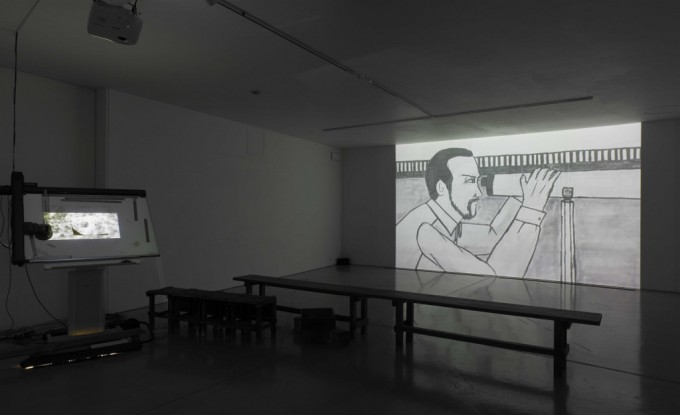
《最後の観測者》
アニメーション・インスタレーション、約12分
撮影:山本糾
存在する不在、現存する気配
近藤由紀
「ラスコー洞窟に足を踏みこむと、私たちはある強烈な感覚に捉えられる。化石人類の最初の遺骸とか、その使用した石器類の並ぶ陳列棚などの前では、たえて抱くことのない感覚である。あらゆる時代の傑出した作品が与えるのが、まさにこの現存の感覚——明晰で燃えるような現存の感覚なのである。」
ジョルジュ・バタイユ『ラスコーの壁画』出口裕弘訳、二見書房、1975年、22−23頁。
作品《最後の観測者》は、「人類最後の人が10万年先にいたとしたら、何を見るだろうかと考える視点を作った作品である」と永岡は言う[1]。言い換えればそれは想像することが難しいと思われるとてつもなく遠い未来を想像するためのある種のメディウム(媒介)である。だがこの作品で描かれているのは、科学的、物理的な未来世界の空想物語ではない。それは生身の我々の時間感覚を超えた遠い未来――これは遠い過去と置き換えることもできるだろう――にあったとしても我々人類が共有しうる何か、同じように見つめている何を想像するための寓話である。
風速計がからからと回り、レジ袋が所在なげに舞う白い場面に一本の線がひかれ、その線から駅構内が広がっていく。レジ袋は人気のない駅や、整然としすぎる町を通り過ぎ、その世界が無人であることを示唆していく。ビルの屋上にはその世界を望遠鏡でのぞく一人の男がいる。男はロープウェイで山頂の小屋へと向かい、小屋に置かれた机に座る。窓からはビルが立ち並ぶ先ほどの町並みが見える。しかし男が窓に手を伸ばし、読めない文字で書かれた手紙を一枚床に捨てると、林立するビルもまた一つ消えてなくなる。床に落とされた手紙は山となり、むくむくと起き上がり、女性の顔をもつ人型になる。男が立ち上がって小屋の外に出ると、その紙人もまたついてくる。紙人とともに再びロープウェイに乗り込んだ男が降りたった場所には元の町はなく、何もない大地が広がっている。男とその大地を眺めていた紙人は、不意に崩れ、元の紙の山に戻る。男が何かを叫ぶが、聞こえない。
この映像と同じ空間にはドラフターの上に鉛筆の線が消された痕跡が残る白紙の「原画」が置かれている。その上にはいつまでも形が定まらず、ぐるぐると回り続ける黒い渦のような画像が投影されている。それは同じ空間で上映されている映像の内容や永岡が提示したテキスト[2]と重ねられることで、処理の終わらないコンピュータ画面のように、いつまでも答えの出ない問いを続ける終わりのなさと、私たちの想像の限界を示唆しているかのようである。
別の部屋の壁面には丸くくりぬかれた画面にありふれた風景が次々と映し出されていく。それらは壁の穴が目になったり、消火栓の輪郭が横向きの顔になったりするなど、それぞれの風景の特徴を生かしながら次第に女性の顔へと変わって行く。女性たちは時にまばたいたり、立ち上がったり、口を動かしていたりするが何を言っているかは分からない。それはまるで男がのぞいている望遠鏡の像のようにみえる。さらに具体的な特徴がほとんど重なっていないかのような風景が次第に女性の顔に変化していく様は、この男の孤独と妄執を強く感じさせる。
人の気配を探し続ける「最後の観測者」と手紙の山から作られた女性は、まるで最後のアダムとイヴのようにもみえる。ここでのイヴはアダムの物理的な身体からではなく、男の記憶、あるいはその妄想から生まれた「生命」である。だからこそ彼女は男にとっての完全な客体ではないのだろう。一方その誕生は男以外の人間が残した存在の痕跡がトリガーとなっている。不在の痕跡を探し、集めていた男が窓に貼っていたのは、自分以外の他者の形見としての街並みであり、読めない手紙である。それら他者の存在の痕跡がイヴを生み、イヴは痕跡のないところではその姿を保つことができない。これは我々の歴史や考古学の探求や、過去の文化や文明に触れたときの内面的な動きを暗示するかのようである。そう捉えると、男があらゆるものにイヴを見出していく姿は、彼の孤独の強さというよりはむしろ、知的好奇心とその探求を通じて時に露わになる、超時間的な人間の存在を求める人類の執念のようにもみえてくる。
永岡の動画作品は、白い紙に鉛筆でドローイングを描いては消すを繰り返し、撮影したそれを早回しすることで作られる。制作の痕跡が意図的に残されている作品は、記憶や時間性が主題として内在しており、制作自体がすでに不在の存在や痕跡と関わっている。だがこの作品においては映像に映り込む現実の制作の姿そのものが、「最後の観測者」の姿と重なっていく。どちらともあらゆるものが無から作られ、同時にあらゆるものが無に帰していく。前出のドラフターの下には、全てのイメージがその存在すら曖昧な虚構にすぎず、最後に残った物理的な痕跡として消しカスだけがうずたかく積まれている。だがその消しカスに含まれた黒鉛の粉が、一つの物語世界を今眼前に現しているのだ。
最後の観測者は何を見るのだろうか。そして彼は何を探し続けているのだろうか。先のバタイユの言葉を借りれば、おそらくそれはこの茫漠たる時間の中で消えて行った存在の「徴」であり「現存の感覚」だろう。一方永岡はこの作品に対する文章を「我々は彼の視線の先に居る。我々が彼の視線の先に居る」[3]という言葉で終わらせている。そこにはこの観測者を想像し、そこから過去を眺める視点を借りただけではなく、遠い未来にいる最後の観測者が見つけ出す自分自身の痕跡を自覚し、彼に対してその視線を投げ返す意識を感じさせる。我々は最後の観測者に何を残せるのだろうか。何が文明を想起させ、何が根源的な存在として、最後の観測者にイヴを想起させることができるのかと。そこには個々人の生きた証ということだけではなく、あらゆることが消え去り、すべてが忘れ去られるであろうずっと先のある場所に、それでも伝わる価値を創出しようとする人間のあるいは芸術家の欲望のようなものが感じられる。
[1] 2015年7月25日アーティスト・トークでの発言。
[2] 「今回は、人類最後の人について描こうと思う。我々は10万年という随分遠い未来について考えねばならない。(中略)これほどの遠い時間的隔たりのある未来を如何に思い描いたものか。単なる空想をこえて考えようとするほど、このことが如何に難しいかを実感するのみだ。そこで、ひとつの仮説を置く。10万年後の或る日、我々人類が最後の一人になるかもしれない。と。それでは、その時その人間は一体何を見るのか?途方もない孤独の中で、諦めつつも誰かを待ち続け、或は探し続けるのかも知れない。そして見渡す限りの街、景色を人類史の最終章として受け取ることだろう。この中で、彼(彼女)は我々の気配と出会い、過去の人間の営みを眺めるのだろう。故に、我々は彼の視線の先に居る。我々が彼の視線の先に居る。」(永岡大輔が展覧会の作品に対する解説として提示した文章より)
[3] 前掲。
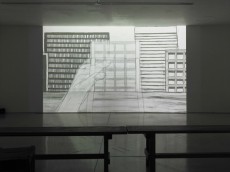
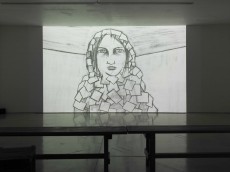
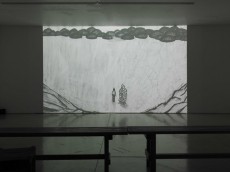
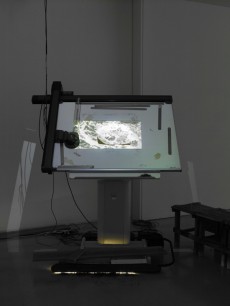
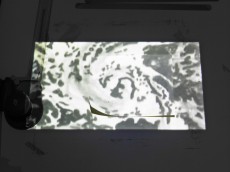
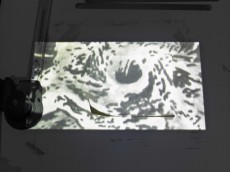
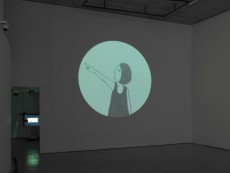
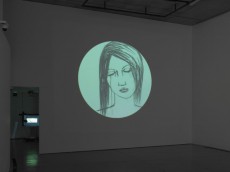
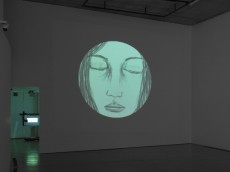
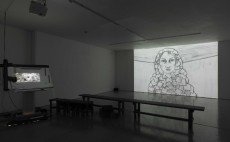
Passage: A Day in Eternity
10:00am-6:00pm, July 25 - September 13, 2015/ admission free
NAGAOKA Daisuke
永岡 大輔

"The Last Observer"
Animation installation, approximately 12minutes.
photo: YAMAMOTO Tadasu
Existing Absence: Signs of Presence
KONDO Yuki
“Directly we enter the Lascaux Cave, we are gripped by a strong feeling we never have when standing in a museum, before the glassed cases displaying the oldest petrified remains of men or neat rows of their stone instruments. In underground Lascaux we are assailed by that same feeling of presence—of clear and burning presence—which works of art from no matter what period have always excited in us.”
Georges BATAILLE, Prehistoric Painting: Lascaux or the birth of art. (1)
According to NAGAOKA Daisuke, The Last Observer is a work “that offers a viewpoint from which you would imagine what the last human being would see if he lived 100,000 years from now.” (1) In other words, it is a kind of medium for us to imagine the incredibly distant future, which is hard to imagine. What is depicted in this piece, however, is not a fantasy describing a scientific and physical future world. It is a fable for humans to imagine something that can be shared or something that we are all watching in the same manner―the distant future beyond our flesh and blood sense of time. This distant future may be possible to be replaced by distant past.
An anemometer is rotating and a plastic shopping bag is flying around against a white background. A single line is drawn and there unfolds a scene of station precincts. The plastic bag goes past the deserted station and the town looks too neat, suggesting that this world is deserted. On the roof of a building is a man looking at this world through a telescope. He rides on a ropeway to go to a cottage at the top of the mountain and sits at the table in the cottage. The city with many buildings where he comes from is seen from the window. When the man reaches out his hand for the window and throws away a sheet of letter written with illegible letters onto the floor, one of the buildings disappears. Letters thrown away on the floor are piled up like a mountain, and they swell up and become humanoid with a female face. As the man stands up and goes out of the cottage, that paper person follows him. When the man goes down the mountain with the paper person by ropeway, he finds nothing of the town at the place where he lands. Firm ground spreads with nothing to see. The paper person watching the ground with the man suddenly falls down and becomes a mere pile of paper again. The man cries out but nothing is heard.
In the same space where this video is shown, there is a drafting board, and on it are original drawings of the “blank sheets of paper” which show traces of erased pencil lines. What is projected on it is an image looking like a black whirlpool, which turns round and round endlessly without fixing a form. It seems to suggest, as it is overlapped with Nagaoka’s text (2) and the video contents presented in the same space, that there is endlessness of asking an unanswerable question like a stuck computer screen or limitation of our imagination.
On the screen hollowed round on the wall in another room, commonplace sights are projected one after another. The characteristics of the respective scene gradually turn into female faces, such as a hole on the wall for an eye or the outline of a fireplug for a profile. These women sometimes blink, stand up, or move their mouths speaking something unknown. They seem like images the man is looking at through the telescope. Observing how the scenes change into female faces, although each specific feature does not seem to be alike, we are strongly impressed by the loneliness and deep-seated delusion of this man.
The Last Observer looking for a sign of a human being, and a woman made by a mountain of letters, could be the last Adam and Eve. This Eve is not Eve made out of Adam’s body but “life” coming from the man’s memory or imagination. Probably that’s why she is not a perfect objective being for the man. On the other hand, her birth has been triggered by traces of the existence left by humans other than this man. What the man, who was looking for traces of absence and gathering them, pasted on the window are a cityscape as a keepsake of someone other than himself along with illegible letters. The traces of the presence of others have produced Eve, and she is unable to keep her form where there is no trace. This seems to imply our inner reactions to our historical, archaeological explorations or our contact with the past culture and civilization. As viewed that way, the way how the man discovers Eve in everything seems to indicate, not his strong loneliness, but tenacity of the human race wishing for certainty of super-temporal human existence, temporarily revealed by intellectual curiosity and pursuit of it.
To produce his video pieces, Nagaoka draws in pencil on white paper and erases the drawings repeatedly and fast-forwards the filmed parts. In his works in which the traces of production are intentionally left, memories and temporality are inherent as subjects, and the production itself is already related to existence and traces of absence. In this work, however, the state of production actually recorded overlaps with “the last observer.” In them both, everything is made out of nothing and at the same time,
everything ends in nothing. Under the above-mentioned drafting board are eraser dust piled up as physical traces of the last thing that has remained, showing that all images are only fictional, even its existence is ambiguous. Yet, the graphite powder in the eraser dust now reveals a narrative world before us.
What does the last observer see? What does he keep looking for? To use the above-mentioned Bataille’s words, it is probably “sign” of existence that disappeared in this boundless time and “feeling of presence.” (3) On the other hand, Nagaoka ends his text concerning this work with the following words, “We are ahead of his eyes. We are the ones who are ahead of his eyes.” There, imagining this observer, the artist did not only borrow his viewpoint of looking at the past but is aware of his own traces to be discovered by the last observer in the distant future, and consciously throws back that observer’s gaze. What can we leave to the last observer? What reminds him of civilization, and what would make the last observer (a fundamental presence) think of Eve? In a distant future, we perceive not only individuals’ proof of their lives but also find values that humans or artists desire to create, which will be passed on even at a very remote place where everything else has faded away or been forgotten.
(1) Georges BATAILLE, “Lascaux and what the work of art means,” Prehistoric Painting: Lascaux or the birth of art, trans. Austryn Wainhouse (London: Macmillan, 1980), p.12.
(1) According to his comment in the artist talk held on July 25, 2015.
(2) “I want to draw the final human. I must envision a far-off future, 100,000 years away. (snip) How would those early men have envisioned such a temporally distant future? The more I try taking this idea beyond a mere daydream, the more I am struck by how challenging it may actually be. It is there that I posit a hypothesis. Perhaps we are the ones who will become the last of mankind, one day 100,000 years from now.
When the time comes, what will that last person see? In an outrageous loneliness, ready to resign to their fate, they may continue waiting or continue searching for someone. Perhaps they will look out upon some landscape, stretching as far as the eye can see, and accept it as the final chapter of human history. In the midst of their surroundings, perhaps they will catch a glimpse of us and gaze upon the past actions of man.
We are the ones currently living out those actions, consequently standing in the last observer’s line of sight.” (written by NAGAOKA Daisuke, translated by Alex QUEEN)
(3) Bataille, “The birth of art,” p.11.










